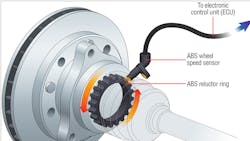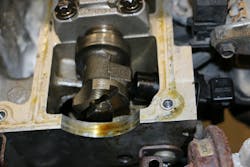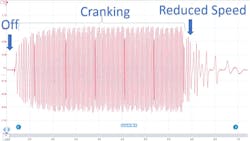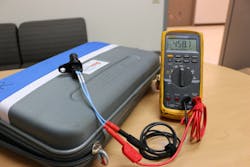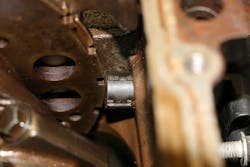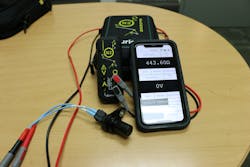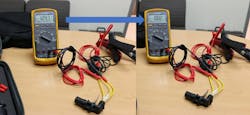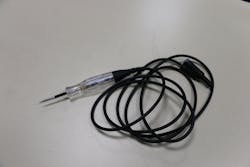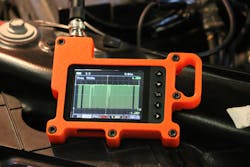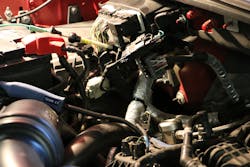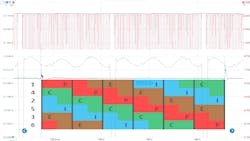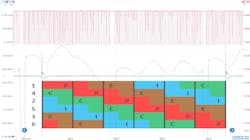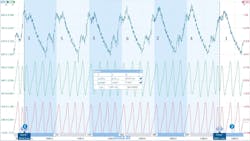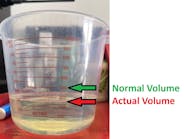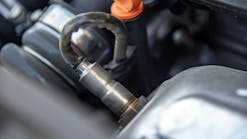A comprehensive approach to speed sensors and diagnostics
As a technical instructor at a public college, I typically embed diverse methods of testing multiple systems for my student population. Such a routine provides similar outcomes for students regardless of available tools, equipment, materials, and supplies at their future site(s) of employment.
Fortunately, many technicians and tool developers have created strategies that provide simple and intermediate methods for generating test results to objectify mechanical relationships among engine components.
Two of the most common engine speed sensor designs are variable reluctance and Hall effect. In this article, I will provide the following:
- Theory and operation of both common sensor designs
- Diagnostic methods that are proven benefits of both designs
- Procedural information to enhance your diagnostic routines when confronting systems that rely on speed/position sensors
To begin, I need to describe the hybridized term of speed/position. Speed projects a measurement of distance divided by time. Position describes the location of componentry to a reference point. Knowing the fundamental relationship between speed and location enhances our ability as technicians to use features embedded in common digital storage oscilloscope technology to enhance our diagnostic methods when addressing driveability concerns that rely on such fundamental principles.
Determining speed and position
Variable reluctance (also considered analog) sensors use concepts of magnetism to generate values that project an increase or decrease in voltage based on the relationship to moving components. These sensors use two wires, rely on a coil of wire, and house a permanent magnet within the sensor assembly.
Using a nearby reluctor wheel, the variable reluctance sensor generates a near and dense magnetic field, converts the field to voltage, and generates an analog voltage output later converted to digital by a receiving module. Such a design also creates the necessity to share events that impact sensor output.
In relationship to a reluctor tine (tooth) on a reluctor wheel, as the tooth approaches, the internal magnetic field of the variable reluctance sensor will be more centralized on the windings (in proximity to its housing), therefore creating a positive rise in voltage output of the sensor (Figure 1).
As the reluctor tine moves away from the sensor element, an inverse reaction occurs, creating a decrease or negative response of energy concentrated within the winding. Due to this notion, the sensor creates an analog signal, an AC voltage output. Knowing that this relationship occurs also creates a demand to understand such a sensor's behavior based on speed.
Variable reluctance sensors do not generate output based on just proximity but rely on frequency in proximity to a rotating component to increase voltage output. As speed increases, voltage output and frequency increase. As speed decreases, voltage output and frequency also decrease (Figure 2). As a result, this style of sensor is considered passive.
Another fortunate idea related to this sensor's design is that traditional electrical values may be used to infer conditions. That value, specifically, is resistance. Manufacturers often provide such resistive values to generate go, no-go specifications for component conductivity (Figure 3).
Hall effect sensors (those that convert analog values to digital values internally) have become more common in the automotive industry. These sensors rely on similar interactions among static and dynamic components as variable reluctance sensors but have the power to convert analog values to digital values internally. Such design is beneficial for two major reasons:
- The sensors do not output a variation of voltage (dependent on time)
- The sensors generate a language (digital) already familiar to receiving modules
The Hall effect sensor is equipped with three wires: power (range up to source voltage), ground (as the sensor is a load-consuming supplied energy), and signal (as the sensor provides internal analog amplification and digital output upon the fluctuation of concentrated magnetism).
The Hall effect design is also unique in the sense that its manufacturers do not provide traditional points of measure for static resistive value. Essentially, a Hall effect Sensor is treated as an engineered load requiring power, ground, and a predetermined threshold of voltage output based on proximity to an exciter, therefore forcing the solid-state electronics internally to generate a traditional digital signal (Figure 4).
In contrast, the only fundamental relationship Hall effect sensors have in common with variable reluctance sensors is frequency. As proximity to a reluctor tine increases and decreases more rapidly, the sensor’s frequency climbs while maintaining consistency in output voltage.
This circuit design is considered superior, as modules are only capable of immediately recognizing digital inputs for data (therefore requiring no analog to digital conversion internally) to predict the speed and/or position.
Testing sensor functionality
Tools that can be implemented for testing purposes include a digital multimeter, test light, and oscilloscope. While scan tools can also be used to determine a module's ability to receive and/or report speed variations, this method requires data to be transmitted from the sensor to a control module, then reported in a delayed 'live' display on a scan tool for interpretation. It is not always an ideal way to approach speed/position sensor component-level testing.
In the context of using a digital multimeter, speed must be considered. DMMs are great for measuring steady variables that commonly include voltage, current, and resistance, but are not ideal for determining rapid peak captures when detecting the amplitude of the signal output of a component with a considerable frequency. In the case of a variable reluctance sensor, a DMM proves valuable for measuring static continuity and dynamic voltage consumption during operation throughout the positive and negative connections within the circuit (Figure 5).
In the case of a Hall effect sensor, a DMM proves beneficial for measuring power supplied to the sensor, and energy remaining (or consumed) on the ground side of the sensor, but it has limitations in displaying a frequency that could be easily interpreted for diagnostic purposes.
If referencing service information for DTCs, many OEMs may recommend using a DMM to assess a Hall effect CKP's output. As the sampling capabilities of a DMM are limited, peak and valley voltages are not often detectable, therefore displaying an average output.
In the Gen 2 LS engine, General Motors specifies a signal voltage output between the range of 4-6 volts when measuring with a DMM actively, though actual voltage output switches from near 0 volts to near battery voltage (Figure 6).
Haakan Light, operator of Shotgun Diagnostics, provided critical feedback for this article's development. In doing so, he indicated a test light could also be used for diagnostic purposes. While using a controlled engineered load to assess speed/position sensor circuit functions, one could infer illumination of a test light when checking power availability, pulsation of signal, and energy remaining in a circuit is illustratable with this tool. All would require further pinpoint testing but using such a tool has its place in our diagnostic routine (Figure 7).
In the case of using a DSO (Digital Storage Oscilloscope) to assess speed/position sensor performance, options are almost limitless. For a quick capture, I typically use the AESwave uScope. It is a single-channel DSO with a +/-40V (80V total) range, can measure 10mV to 10V vertical division on a 1x probe, displays 10uS to 10S per horizontal division, and has a capable sampling rate of 1Msps. This tool also has capture (storage) capabilities, a dense array of preset options for component testing, adjustable points of measure, and fits in the palm of your hand. It can display DC (Direct Current) voltage inputs for traditional digitized speed/position sensors (Hall effect) and has an AC voltage filter option for variable reluctance speed sensors. Overall, this DSO is capable of measuring, displaying, and capturing data critical for diagnosing speed/position sensors (Figure 8).
For more enhanced functions, I typically use a Pico 4425A DSO from AESwave. This unit has four channels, utilizes Pico BNC+ probes for auto identification and/or probe potential energy supply, and has a user interface that is simple to navigate. This tool also has enhanced capabilities we will explore to determine mechanical relationships with data derived from live captures.
To begin testing any speed/position sensor with a DSO, I rely on OEM or aftermarket diagrams to locate the sensor and access the signal generated by the sensor.
In the case of my 2017 Ford F-150, the crankshaft position sensor was not easily accessible, so I decided to use the PCM as the locating point for signal measurement (Figure 9).
Using service information, I also identified the type of the sensor as Hall effect (since it contained voltage, ground, and signal connections). Service information also provided the theory and operation of this unit, indicating a reluctor wheel tooth count of 58 teeth. For every revolution of the crankshaft, 58 digital pulses must be displayed followed by two empty high slots of the sensor element. For a complete four-stroke cycle to be witnessed, this rotational event must happen twice.
An oscilloscope may also be used (with a bit of creativity) to project the power contribution of cylinders in less familiar platforms. Synchronizing this event with cylinder 1’s secondary ignition output and converting the frequency of the crankshaft position sensor to a viewable math channel display also provided a broad image of cylinder contribution.
To reference cylinders, I used the overlay feature of The Driveability Guys' TDC2 software as an indication of cylinder cycle events. Using this methodology provides a clear and consistent benefit when locating cylinder misfire events that are potentially unreported or misreported (Figures 10+11).
Testing techniques apply to diesel engines as well
As the program I serve also maintains a basic diesel certificate, students explored the relationships of cranking current and cylinder identification on a 2001 Cummins ISM 330-equipped Volvo Day cab. This system uses a variable reluctance camshaft position (titled engine speed) system but maintains two points of input from the sensors:
- One for rpm display
- One for engine control functions
As measuring compression in this engine may require up to 7.1 hours of book time due to injector removal and installation, students concluded that a DSO could provide imagery to infer engine condition more conveniently. To do so, the students located and back-probed the signal wire of the engine speed sensors, connected an amp clamp to the B+ feed on the massive starter to measure current, and manually supplied source voltage to the starter solenoid feed.
The capture indicated 25 pulses from the engine speed sensor per revolution, with two pulses being near one another. In a basic investigation with a few phone calls, students concluded that shorter pulses were used to indicate the location of cylinder number 1's compression event.
Overlaying the firing order provided sufficient information to conclude each cylinder’s contribution was similar and took less than 1 second to conclude the engine's mechanical condition (Figure 12).
To conclude, we've explored the basic theory of two common speed sensors, methods for testing statically, and more advanced dynamic methods often critical in the diagnostic process. If you have the tools and equipment described in this submission, I must recommend using them to your most enhanced benefit for diagnosing speed/position sensor-related concerns. Diverse methods of assessment can provide accommodation regardless of your inventory.
